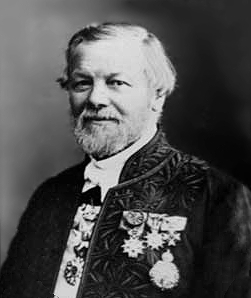Achille Delesse facts for kids
Achille Ernest Oscar Joseph Delesse (born February 3, 1817 – died March 24, 1881) was a French scientist who studied rocks and minerals. He was a geologist (someone who studies the Earth's physical structure and substances) and a mineralogist (someone who studies minerals). He is famous for creating the Delesse principle, which is a way to understand 3D shapes from 2D slices, especially useful in geology.
His Journey and Work
Achille Delesse was born in a city called Metz in France. When he was 20 years old, he started studying at the École Polytechnique. This was a very important school for science and engineering. After that, he went to the Ecole des Mines. Here, he learned from famous geologists like Jean-Baptiste Élie de Beaumont.
In 1845, Delesse became a professor at the University of Franche-Comté in Besançon. He taught about mineralogy (the study of minerals) and geology (the study of Earth's rocks and history). A few years later, in 1850, he moved to Paris. He became a geology professor at the famous Sorbonne. Later, in 1864, he also taught about agriculture (farming) at the Ecole des Mines.
Achille Delesse passed away in Paris on March 24, 1881.
What He Studied
As a young engineer, Achille Delesse explored and described many new minerals. Minerals are natural solid substances found in rocks and soil. He then started to study different types of rocks. He even found new ways to identify them.
He described rocks like melaphyre, arkose, porphyry, and syenite. He also studied igneous rocks, which are formed from cooled magma or lava. He looked at these rocks in places like the Vosges mountains, the Alps, and Corsica. Delesse was also very interested in metamorphism. This is the process where rocks change due to heat, pressure, or chemical reactions.
In 1858, Delesse created special maps of Paris. These maps showed the geology and where the underground water was located. He made similar maps for the areas around Paris, like the Seine and Seine-et-Marne regions. In 1880, he made a map of Seine-et-Marne that showed how the type of soil was connected to the geology of the area.
Delesse also helped write a yearly report called Revue des progrès de géologie (Review of Geological Progress). He worked on this from 1860 to 1880. His studies on the rocks found deep under the sea were very important. He also wrote several books, including:
- Recherches sur l'origine des roches (Research on the Origin of Rocks) in 1865.
- Étude sur le métamorphisme des roches (Study on the Metamorphism of Rocks) in 1869.
- Lithologie des mers de France et des mers principales du globe (Lithology of the Seas of France and the Main Seas of the Globe) in 1871.
Awards and Recognitions
Achille Delesse received many honors for his work. In 1863, he became a member of the American Philosophical Society. This is a famous group that promotes useful knowledge. In 1879, he was also chosen to be a member of the French Academy of Sciences. This is one of France's most important scientific organizations. In 1878, he became the inspector-general of the Corps des mines, a high position for mining engineers in France.


